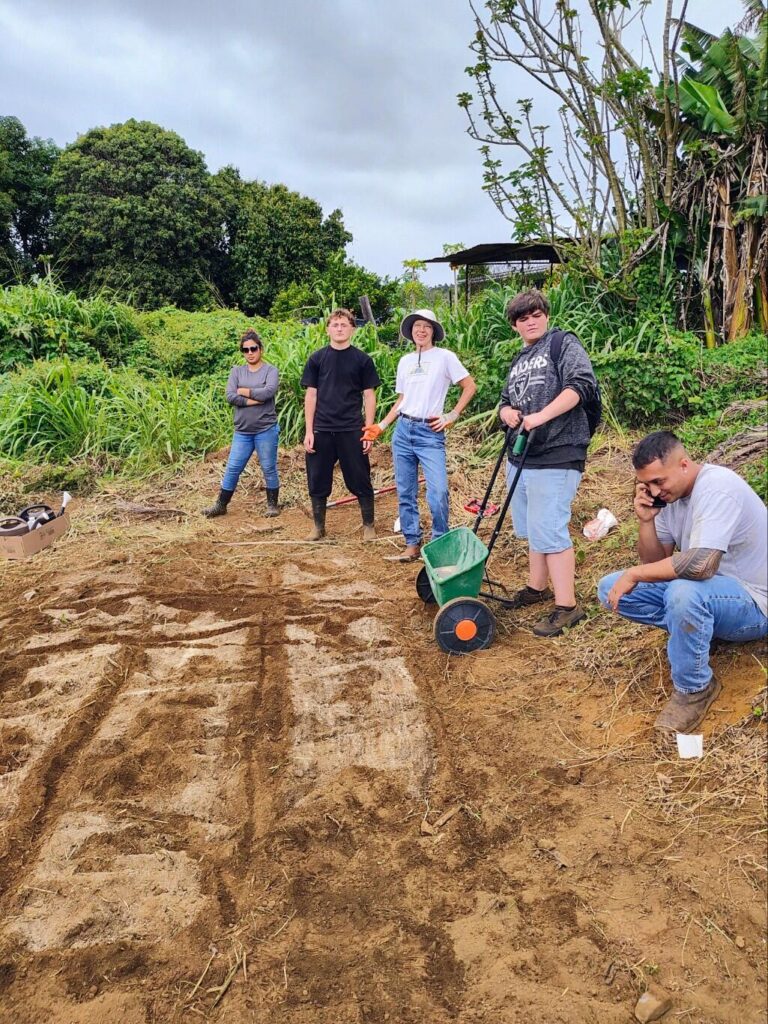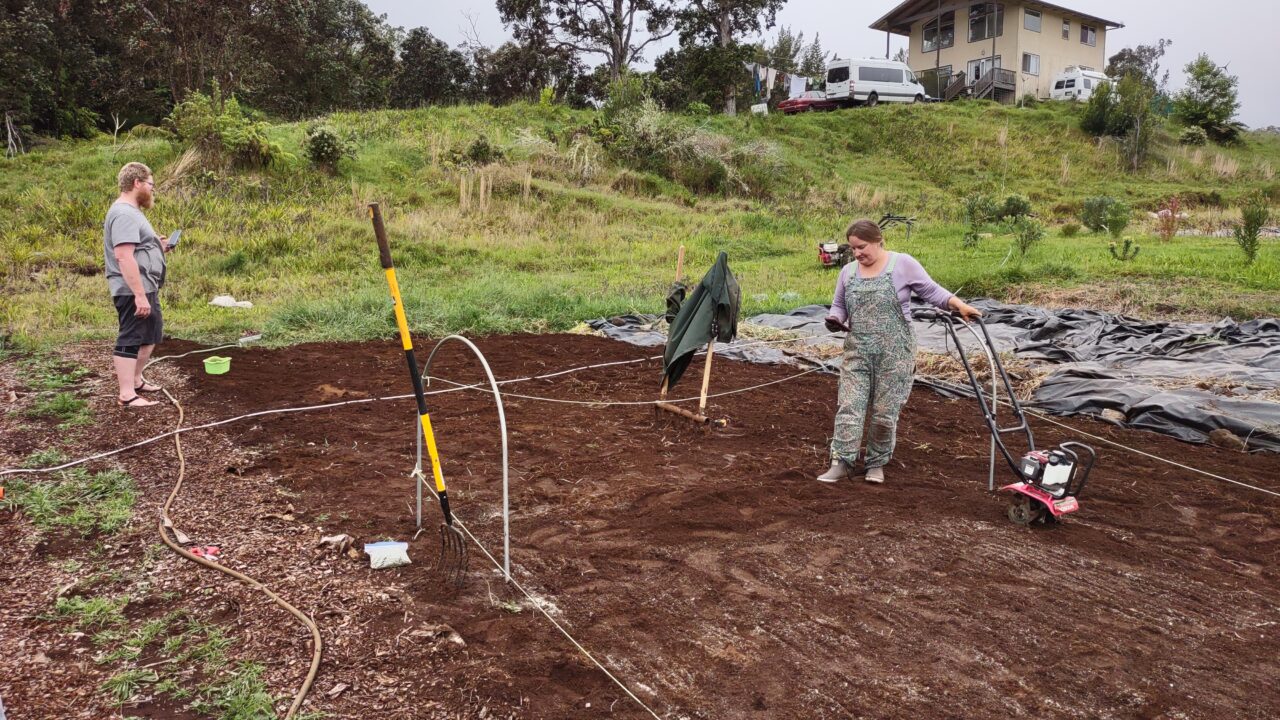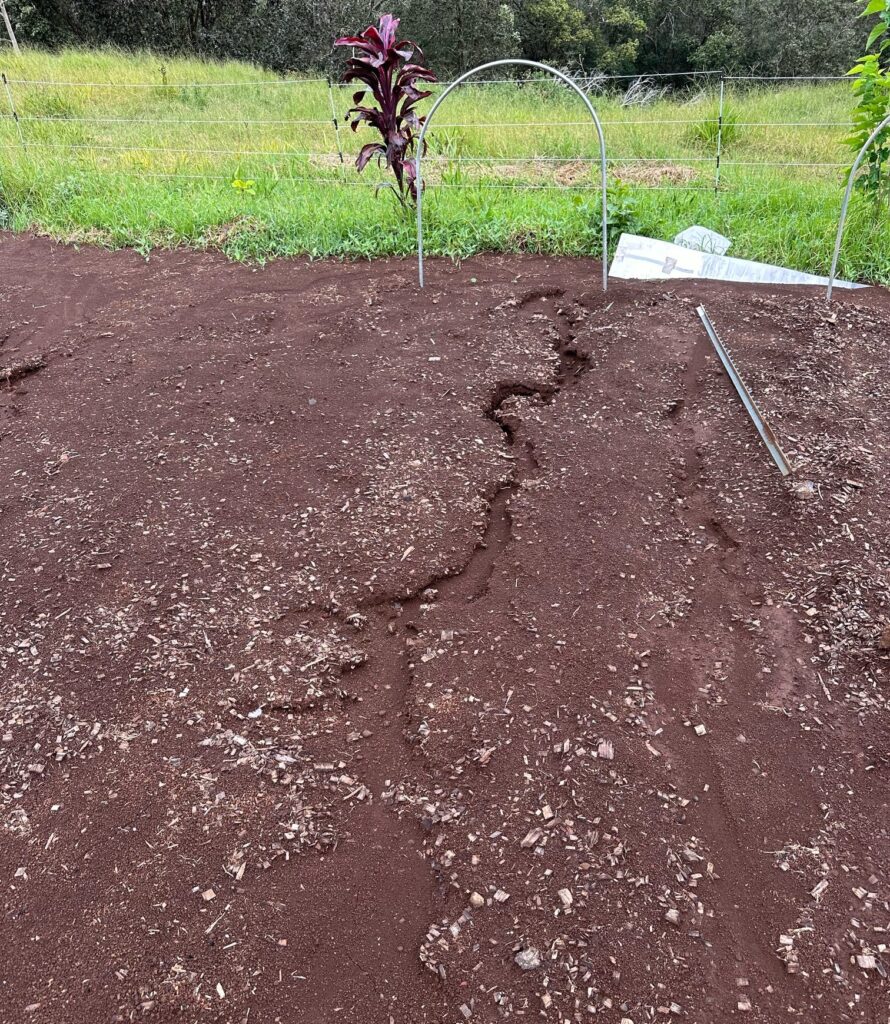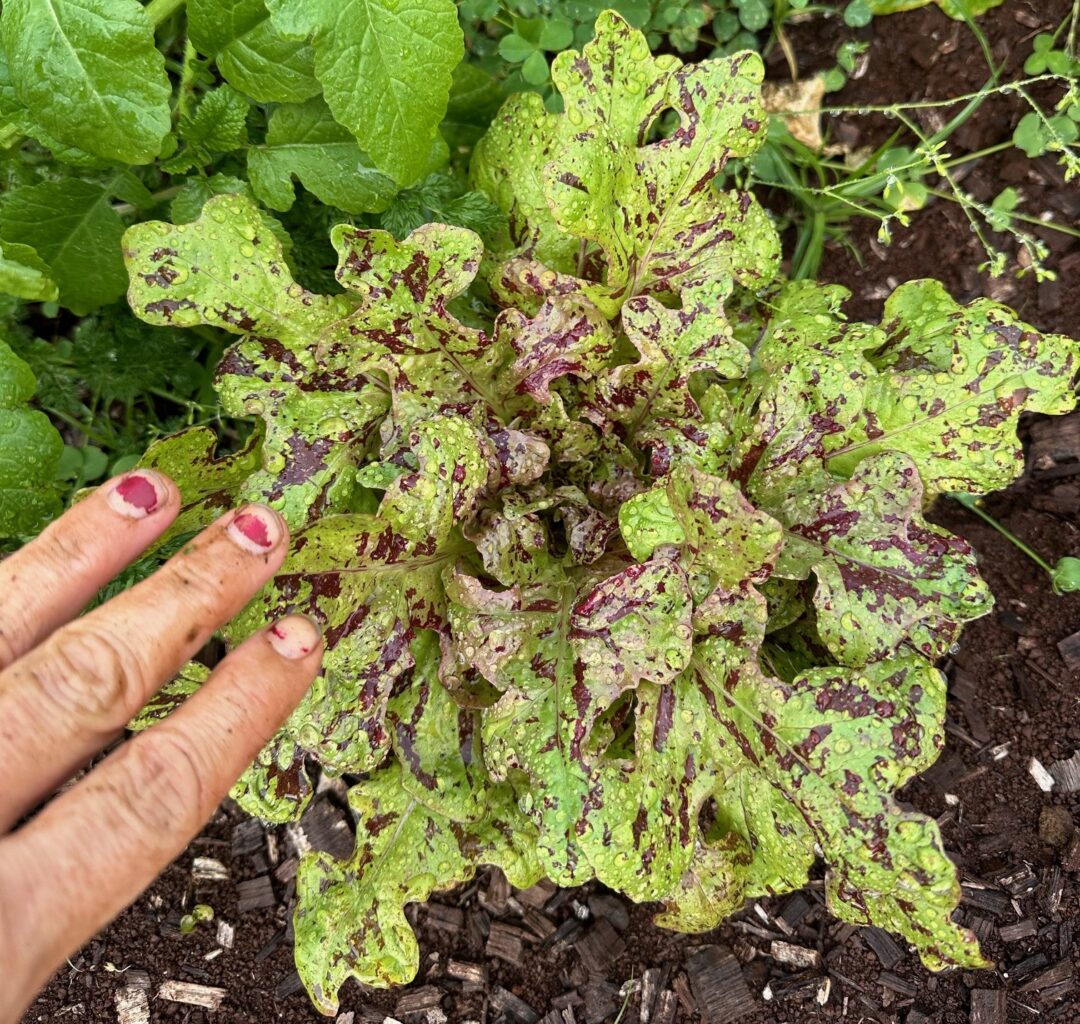Six Big Island farms participated this year in the grant-funded Nutrition Grown Farmers’ Educational Program and Farm Trials. This program was funded largely by the Bell Charitable Foundation. (Access through @altafiber or #BCFBelieves.) Big Island Resource, Conservation & Development, Dr. Bogs and the participating farmers are grateful for the support.

The educational program included Dr. Bogs’ online Perfect Soil™ course, Zoom meetings, Dr. Bogs’ book–Beyond Organic: Growing for Maximum Nutrition and Flavor, Nutrition Grown® soil analyses, and side-by-side growing plots farm trials.
The trials included comprehensive pre- and post-trial Nutrition Grown® soil analyses (including microbiology), organically-approved soil amendments, and help with the application of those. In every case, the fertilization of the control plot was left to the farmer’s discretion—for them to apply what they usually use and thought best.
The farms ranged in size from 1 to 10 acres, with the average being 6 acres. The median size of a farm in Hawaii is 5 acres (2017 Census of Agriculture).
The farmers are Oliver Dominguez of Mountain View, Tony Vera of Mayan World in Kea`au, Lisa Cates of Naalehu, Jim Cain of Waipio Valley near Honoka`a, Jordie and Kimo McEwen of Paauilo, and Kaweni Ibarra and Jesse Denny of Pahala High School. All farmers were set to grow some variety of corn, which was chosen based on their location. The climates of the various farms varied greatly due to differences in elevation and rainfall.
The soil analyses revealed numerous imbalances which were addressed with custom-made fertilizer mixes for each farmer. Post-trial soil analyses were compared to pre-trial values with an average of 10 of 22 measured soil parameters significantly improving.
Here is the preview photo example of the differences that can be had through proper soil amending. These sweet corn plants were grown in adjacent beds at the same time and in exactly the same way except the Nutrition Grown corn on the right had soil that was amended according to the Beyond Organic Growing System (BOGS).

PHOTO: Oliver’s corn fields showing the difference in growth under different soil treatments.
Oliver Dominguez of Lotus Buddhist Monastery in Mountain View —
This is an 8-acre farm which feeds the monastery residents and guests. They grow a large variety of vegetables and fruits. Overages are sold at the weekly Volcano Farmers’ Market. They supply produce to Da Box program run by the Food Basket and Sugarhill Farm CSA. They also sell vegetables to a grocery store in Hilo.
The above photo is from Oliver’s corn trial. You can clearly see a difference in the size of the crops, which were planted at the same time.
Soil Reports: Mountain View is a very rainy area, which means that a lot of the minerals in the soil have been leached out. The initial soil report showed very low levels of sulfur, phosphorus, magnesium, potassium, boron, manganese, zinc, cobalt, and molybdenum. By contrast, the calcium (had been added in the past), copper and aluminum were high. Imbalances like this can be remedied. Depending on the severity of the imbalances, correcting the soil can take years of diligent work. However, we usually see significant improvements even in the first season.
The Nutrition Grown plot had a full array of the needed nutrients and microbes applied. The control beds had 15-15-15, dolomite, borax, and zinc sulfate applied. It is recommended to wait at least 3 weeks before direct seeding into an amended plot to allow the nutrients to be more evenly distributed in the soil.
Oliver needed to plant at the 2-week point, which seemed to work out fine. He planted Xtra Tender sweet corn on May 15th. He foliar sprayed copper on both plots in week 7. Oliver harvested on August 3rd. The control plots averaged 87 ears of corn versus the Nutrition plot which produced 165 ears of corn. Nearly double the yield!

PHOTO: Oliver at the Monastery gate with a soil sample.
The soil from the Nutrition Grown plot was retested in October. The soil analysis results from pre-trial are compared with post-trial values in the following chart. Keep in mind that corn is a heavy feeder and can deplete the soil of nutrients. Overall, the Nutrition Grown soil improved in 11 of 22 measured parameters.
Soil Reports NOTE: When discussing soil mineral levels and other soil parameters, we are using the term “high” to mean too high; “OK” levels are the desirable levels.

Soil Microbiology—
Beneficial microbiology in the soil is important to hold nutrients in the soil and make them available to the plants. Each farmer in the program was supplied with a broad-spectrum microbial inoculant. Overall, the farmers in the program had good results with building beneficial microbiology in their soils. (See table of microbiology of all participants later in this report.)
Oliver’s Pre-trial microbiology report compared to post-trial report: Pre-trial bacterial level was 100/slide field on the initial check, and 10/slide field on the recheck. These are extremely low numbers, as we would like to see about 2000 per slide field. Post-trial bacterial level was much improved to 600/slide field on the initial check, and 40/slide field on the recheck. Other soil microbiology parameters—beneficial fungi, protozoa, and nematodes–did not show up on the pre-trial. One protozoan showed up in the post-trial soil. Protozoa are wanted in small numbers as they eat bacteria, recycling nutrients into the soil. No beneficial fungi or nematodes showed up in the post-trial.

PHOTO: Some of Oliver’s delicious sweet corn from Xtra Tender organic seed.
Course and Farm Trial Evaluation comments by Oliver:
Question: “What changes happened in your Beyond Organic amended soil/plants versus the control?”
Oliver: “Better growth, healthier plants.”
Other comments by Oliver: “Course is very useful because it is based on practice.”
“Analyses and their explanations were the most interesting. The fact that minerals AND biology were analyzed and improved was enriching.”
Lisa Cates’ Farm in Waiohinu near Naalehu–
Lisa has a 10-acre farm where she raises herbs, vegetables and fruits with organic-type methods. She has a booth to sell her produce at the OKK Farmers’ Market on Wednesdays in Naalehu.

PHOTO: Lisa prepping soil for corn planting
Soil Reports: Lisa’s soil has a good Total Cation Exchange Capacity (TCEC), which means her soil can hold a lot of nutrients. A lot of the minerals on the soil analysis, including the trace minerals, were very low. These are needed for the plants as well as for the beneficial microbes. The soil had low levels of sulfur, phosphorus, calcium, potassium, sodium, boron, manganese, copper, zinc, cobalt, molybdenum and selenium. By contrast, the magnesium and aluminum were too high. The soil pH was too low, which can make the aluminum more available.
The Nutrition Grown plot had a custom-made array of nutrients and microbes applied. Because her soil had a good exchange capacity, we were able to add a lot of nutrients. Some minerals, such as manganese, copper, cobalt and molybdenum, can only be added in small amounts over time, so these items may take years to build to the ideal levels. The control plot had Azomite, chicken manure pellets, and compost applied.
Overall, the Nutrition Grown soil improved in 11 of 22 measured parameters as shown below.

Lisa’s Soil Microbiology: Post-trial comparison to the pre-trial report: The soil microbiology is improved. Pre-trial bacterial level was 600/slide field on the initial check, and 150/slide field on the recheck. These are moderate to low numbers. Post-trial bacterial level was improved with an increase to 800/slide field on the initial check, and 40/slide field on the recheck.
Course and Farm Trial Evaluation comments by Lisa:
Evaluation: “What changes happened in your Nutrition Grown amended soil/plants versus the control?”
Lisa: “The Nutrition Grown plants were larger quicker and all produced 2 full ears. The control plot was slightly smaller and not all produced 2 ears.”
Other comments by Lisa: “The course provided great info for general farming knowledge.”
“It was very helpful to have you explain all the language (about the analyses).”
Pahala High School Farm–
Pahala High School has about a one acre farm for teaching students where they grow a variety of vegetables. The ag teacher, Kaweni Ibarra, unexpectedly vacated his position just after we amended the soil for the corn trial. Jesse Denny took over the project, but had some personal challenges which made completing the project difficult. There were supposed to be some paid students over the summer who would help, but their funding got cut. In the end, corn was harvested, but we had a lack of information and data.

PHOTO: Soil Amending Day at Pahala High with students, Dr. Bogs, and ag instructors.
The soil is a fine volcanic ash soil due to its proximity to the volcano and the prevailing trade winds which bring the ash. The soil did have a hard pan about five inches down. There was discussion about addressing this, and it was supposedly shanked to break up the hard pan. The amendments were tilled in with a rotary tiller mounted on the back end of a small tractor. When resampling soil at the end, there was a definite change in soil color at five inches which indicated that the amendments were not tilled into the full six-inch depth we were aiming for.
Soil Reports: The soil has a good Total Cation Exchange Capacity (TCEC), therefore the soil can hold a lot of nutrients. Several of the minerals on the soil analysis, including some trace minerals, were very low. The soil had low levels of sulfur, phosphorus, calcium, sodium, boron, manganese, cobalt, and molybdenum. By contrast, the magnesium, potassium, copper, zinc, and aluminum were too high. The soil pH was a bit low, but corrected with the program.
The Nutrition Grown plot had a full array of nutrients and microbes applied according to Dr. Bogs’ interpretation of the soil analyses.
Due to the lack of records, it is unclear what was added to the control bed, though it was thought to be a typical NPK commercial fertilizer.
There were no records available for irrigation. The Nutrition Grown plot was located up in the back corner of the field, and may or may not have been watered appropriately.
Overall, the Nutrition Grown soil improved in 8 of 22 measured parameters.

Pahala Soil Microbiology: Post-trial comparison to the pre-trial report: Pre-trial bacterial level was 100/slide field on the initial check, and 10/slide field on the recheck. These are very low numbers. The soil microbiology was not resilient. Post-trial bacterial level increased to 2000/slide field on the initial check, and was 200/slide field on the recheck. These represent an amazing 20-fold increase!
Tony Vera’s Mayan World Farm–
Tony has three acres in Orchidland, near Kea`au, where he has a large variety of useful plants and trees. A lot of them are medicinal. Tony uses natural and traditional methods, creating his own soil through composting. He adds rabbit manure from his own rabbits. He has won awards for his large produce. Tony serves as president of two Big Island chapters of the Hawaii Farmers Union United (HFUU). He has been growing Mayan field corn varieties for quite a while and was interested to see how Nutrition Grown methods could be helpful.
Soil Reports: Tony’s soil has an excellent Total Cation Exchange Capacity (TCEC), which means the soil can hold a lot of nutrients. This is great because a lot of the minerals on the soil analysis were very high. However, some of the nutrients were low, and therefore needed to be balanced. The soil had very high levels of sulfur, phosphorus, magnesium and potassium. It was low on calcium, boron, manganese, copper, cobalt, molybdenum and selenium. The soil pH too high at 7.4. The electrical conductivity was also very high, which can cause “burning” of leaves in susceptible plants.
The Nutrition Grown bed had a custom-made array of nutrients and microbes applied. Because his soil had a high exchange capacity, we were able to add a lot of nutrients. Some minerals, such as manganese, copper, cobalt and molybdenum, can only be added in small amounts over time, so these items may take years to build to the ideal levels. Overall, the Nutrition Grown soil improved in 8 of 22 measured parameters.


PHOTO: Tony Vera with his Nutrition Grown corn
Tony’s Soil Microbiology– Post-trial comparison to the pre-trial report: The soil microbiology changed to having a broader array of microbial life, most notably in regards to protozoa. There were no protozoa seen on the pre-trial analysis, but several appeared on the post-trial analysis. We do want some protozoa because they eat bacteria, thus recycling plant-available nutrients into the soil. Pre-trial bacterial level was 900/slide field on the initial check, and 500/slide field on the recheck. These are moderate numbers. Post-trial bacterial level was 500/slide field on the initial check, and 500/slide field on the recheck. The bacteria were being eaten by the protozoa. Post-trial bacteria are now more diverse in variety are considered to be resilient.

PHOTO: Some of Tony’s interesting Mayan field corn varieties. Nutrition Grown at top, control at bottom. He reserved some of his best to be used as seed corn.
Course and Farm Trial Evaluation comments by Tony:
Evaluation: “What changes happened in your Nutrition Grown amended soil/plants versus the control?”
Tony: “There was a larger growth in plants.”
Tony also stated that he enjoyed the course, found the information useful and plans to apply the info. He found the soil mineral analysis and soil microbiology analysis helpful. Tony also found the Zoom calls helpful.
Shield Maiden Farm, LLC—Jordie and Kimo McEwen–

PHOTO: Kimo and Jordie McEwen prepping the soil in the test area.
The McEwen’s farm is 7.42 acres located in Paauilo Mauka. They focus on growing various types of vegetables, herbs and flowers, as well as some fruits. They sell their products through the agricultural cooperative at the local farmers’ market in Honokaa.
Their farm’s high elevation makes for a cool and rainy climate which is not ideal for corn production. Instead, they chose lettuce as their test crop. Unfortunately, the McEwens had health challenges in the family, and they had major flooding rains which washed away a lot of the soil, seeds and plants in the test plot. They got over 17 inches of rain in two days! They had to replant, which caused delays in production. They are currently putting in greenhouses to assist them in the future.
Soil Reports: The McEwen’s soil has a low Total Cation Exchange Capacity (TCEC), which means their soil cannot hold a lot of nutrients. We are working to correct this by adding humates and other organic matter. The pH is also low. Most of the minerals on the soil analysis, including the trace minerals, were very low. These are needed for the plants as well as for the beneficial microbes. The soil had low to very low levels of sulfur, phosphorus, calcium, magnesium, potassium, sodium, boron, iron, manganese, copper, zinc, cobalt, molybdenum, silicon and selenium. By contrast, the aluminum was too high, which is typical in low pH soils. The electrical conductivity was also low.
The Nutrition Grown plot had a custom-made array of nutrients and microbes applied, as well as wood chips. Some minerals, such as manganese, copper, cobalt and molybdenum, can only be added in small amounts over time, so these items may take years to build to the ideal levels. The control plot had biochar, alfalfa, and worm castings applied.
Overall, the Nutrition Grown soil improved in 9 of 22 measured parameters. See chart below.
The McEwen’s Soil Microbiology: Post-trial comparison to the pre-trial report: The soil microbiology is tremendously improved. Pre-trial bacterial level was only 50/slide field on the initial check, and 20/slide field on the recheck. These are very low numbers. Post-trial bacterial level and variety was incredibly improved with an increase to 1650/slide field on the initial check, and 1250/slide field on the recheck. This is an increase of 33 times more bacteria in the soil! The tilth and color of soil was also very nice. They underlaying, unamended soil is still hard and sticky, with obvious differences in color and texture.

PHOTO: Flooding rains that put a big damper on production.

PHOTO: Unfortunately, a lot of the soil in the test plot got washed away.


PHOTOS: Fortunately, Jordie still managed get some beautiful heirloom lettuces to maturity by fall.

Course and Farm Trial Evaluation comments by Kimo and Jordie:
Evaluation: “What changes happened in your Nutrition Grown amended soil/plants versus the control?”
Kimo and Jordie: “Unfortunately, our plots were washed out on 2 different occasions, in a 17 inch rain, and several weeks later in a 5 inch rain that fell in less than 2 hours. Approximately 1-2” of soil was washed off of the plots, along with mulch and into the windbreak tree line. Despite all of this, I would say that the lettuce grown in the test plot was larger, and had less pest pressure. The plants were over all healthier… And the tree line is looking great. I think one of the Mulberries has grown 6+ feet over the summer.
I am really looking forward to completion of our greenhouses, and to put the Nutrition Grown information to use in a protected environment. We have already purchased amendments to make sure that we start our greenhouse production in the best shape that we can.”
Additional comments by Kimo and Jordie:
“We learned so much about our soil, and how much goes into growing a healthier crop. I had only ever worried about NPK and pH, but now we know that there are so many other factors and elements that need to be corrected.”
“Now I feel like we have complete soil.”
“We had an enlightening and enjoyable time with this course. We came in with university education in agriculture, certifications in permaculture and sustainable agriculture and 6+ years of farming experience, and I easily doubled my knowledge and awareness of soil health. I feel more secure in my knowledge about my soil, and how to grow the best, most nutrient dense food that I can for my family and my community.”
Keoluwai Farm in Waipio Valley–Jim Cain—
The sixth farmer in this cohort was Jim Cain of Waipio Valley. Jim runs a wetland kalo (taro) operation on six acres for poi production. He wanted to begin growing corn and sweet potatoes on the banks in between the lo’i. Jim participated happily in some of the Zoom calls.

PHOTO: Overview of Keoluwai Farm in Waipio Valley

PHOTO: Here’s my truck swimming through a stream in Waipio Valley.
Two trips were made into the wilds of Waipio Valley, driving down (and up) a 25% grade and having to traverse two-foot-deep streams to get into the farm. Fortunately, the truck of choice on the Big Island—my 4WD Toyota Tacoma—was up for the task. Soil samples were taken on the first visit and analyzed. The second visit was to deliver the custom soil amendment mix. After that, I never heard from Jim again, even though I left multiple messages in an effort to get in touch with him. If anyone knows what has happened with Jim, please let me know. Thanks.

PHOTO: Jim and Dr. Jana in front of his Waipio Ponies and lo’i on his kalo farm. Some ponies are born on his farm.

PHOTO: Jim standing on his freshly tilled lo’i bank, getting ready for amending and corn planting.
Summary of the Nutrition Grown Farm Trials Project
There were improvements in the soil of all of the Nutrition Grown trial plots. Overall, there was improvement in an average of 10 of the 22 parameters measured.
As you can see in the chart below, soil microbiology improved greatly overall for the farmers in the trials.

The course evaluations submitted by the farmers were overall very positive. They stated that they enjoyed the course and had a good learning experience. They especially liked the comprehensive soil analyses.
Thanks to all the farmers and their helpers who participated!


Recent Comments